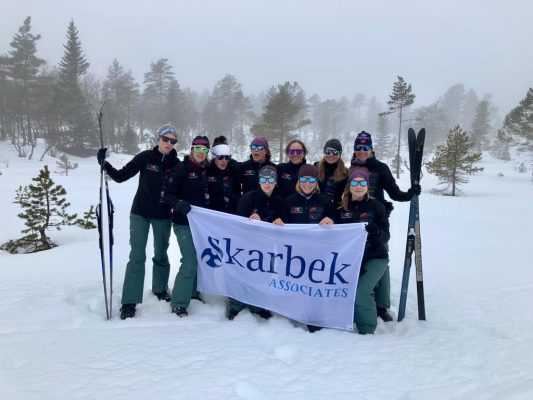On Sunday last, after a long, damp English winter of prep and fitness training, the Forces Wives Challenge (FWC) team of ten women and two reserves, finally boarded a plane to Norway. This is what they had all been working towards: the chance to clip on their skis and journey across the high, sweeping landscape of the Hardangervidda in a re-enactment of one the most daring undercover operations of World War ll in which a group of Norwegian saboteurs, the Heroes of Telemark, risked all to thwart Hitler’s efforts to build an atomic bomb.
Four days into the expedition, with an intensive training period on survival skills and the most efficient mode of travel over snow and ice completed and just prior to departure, we spoke with FWC founder Heather Sharp. How was it going?
‘It’s a massive learning curve’, she says. ‘Lots [of the women] haven’t been away from their families before; most haven’t Nordic skied. There’s lots of falling over, a few bumps and bruises, but with smiles!’
The training took place in the relative comfort of the Joint Services Training Centre in the Setesdal Valley, south of Hardangervidda. Heather could not have sounded more grateful for the professionalism and generosity of the guides, Glyn Sheppard and Matt Larson-Clifford. They have skied the route dozens of times; there is nothing they haven’t seen before, and they happily shared all their hard-earned experience with the team. While the manager Brian Desmond adds emotional intimacy to the legacy of the Heroes of the Telemark, having lived in the area for some 40 years, totally immersed in the history and personally counting some of the surviving saboteurs as friends.
The prime aim is for the whole FWC team, led by Heather, to travel from the start of the route to the finish, and to do so safely in what is one of the most extreme environments in Europe. The women are collectively navigating, pulling pulks (ski sleds ), caring for one another, and making their own decisions every step of the way.
The two messages that have been reinforced loud, and clear, is that the team must be ‘high performing’ and ‘efficient’ – messages of equal pertinence to teams implementing business strategies, and music to the ears of a mountaineer. Their journey, like that of climbing a mountain, is a marathon, not a sprint. Energy is to be conserved in every way possible to sustain strength over the long haul, and it is critical to look after the wellbeing of self and the team.
With this in mind, the purity of skiing the whole route becomes less important; what matters is to get there. Sometimes, skiing will be the most efficient mode of travel; but at other times it will make more sense to sidestep down a steep slope or take off your skis and walk. ‘Go slow to go fast’, is the motto. The guides have taught the women how to expend minimum effort to get up on their feet again after a fall, and to thoughtfully consider something as simple as packing a rucksack. Remember, it might be easier for your buddy to reach for a water bottle, or spare pair of gloves, than it is yourself, and they will need to know exactly where the items are packed.
Good news was that there was room in the huts to accommodate the two reserves, so it is now a team of 12 travelling, not 10 as originally intended. That’s a large number, one that requires each member to be disciplined and look after themselves while constantly considering the team as well. One poor decision can affect the whole group. It can also call for the finest of judgements. I think of a friend of mine in the Arctic: a polite man, not wanting to hold anyone up, who skied on knowing that he had snow in his gloves and lost two fingers to frostbite.
‘One certainty,’ says Heather, ‘is that something will happen that we never thought about.’ But in the same breath, she expresses a confidence that the team has built a resilience; they will pick themselves up and deal with whatever is thrown at them.
‘Some found [the training] harder than others; they bring different skills and have different challenges,’ says Heather. But all of them have taken small steps out of their comfort zones to sign up to the expedition and travel to Norway in the first place. The intensive training was just another step to building resilience and growth.
As I write, this team of 12 courageous women are high on the snow-laden rolling hills of the Hardangervidda, putting all their training into practice to become the first all-female team to re-enact the Heroes of Telemark mission to ski to the Vemork heavy water plant and stop Hitler’s attempt to build an atomic bomb. Personally, I can’t wait to hear about their experience.
